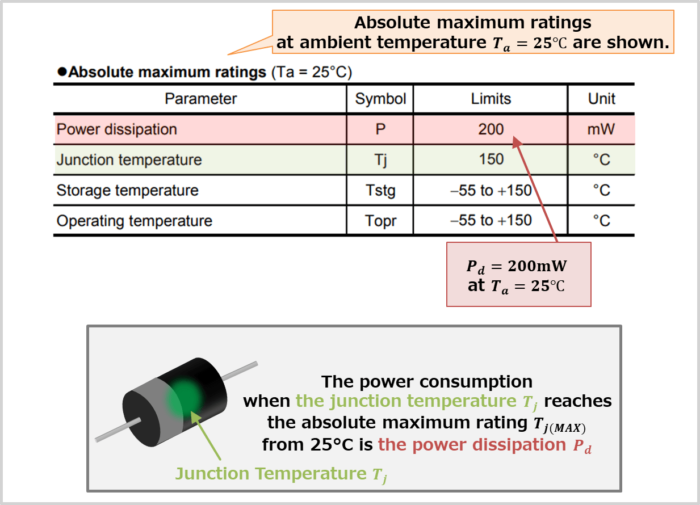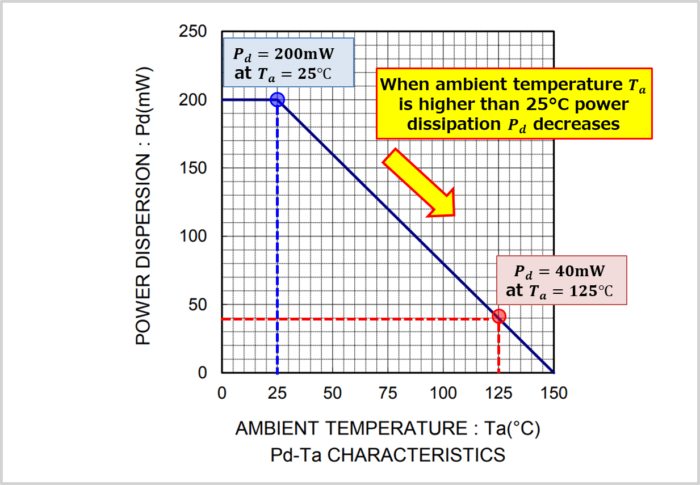Regarding the "Power Dissipation \(P_d\) of Zener Diode", this article will explain the information below.
- Power Dissipation \(P_d\) of Zener Diode
- \(P_d\)-\(T_a\) Characteristics of Zener Diode
Power Dissipation of Zener Diode

The power dissipation \(P_d\) of a zener diode is the power dissipated when the junction temperature \(T_j\) reaches the absolute maximum rating.
The symbol for power dissipation depends on the datasheet, but it is often expressed as \(P_d\), \(P_T\), \(P_{tot}\), or \(P\).
The power dissipation \(P_d\) listed on the datasheet is based on the ambient temperature \(T_a=25\mathrm{^{\circ}C}\). Therefore, the power consumption when the junction temperature \(T_j\) reaches the absolute maximum rating \(T_{j(MAX)}\) from 25°C is the power dissipation \(P_d\) listed on the datasheet.
The power dissipation \(P_d\) is expressed by the following equation using the thermal resistance \(R_{th(j-c)}\).
Power Dissipation Formula
\begin{eqnarray}
P_{d}=\frac{T_{j(MAX)}-T_a}{R_{th(j-c)}}=\frac{T_{j(MAX)}-25}{R_{th(j-c)}}\tag{1}
\end{eqnarray}
The datasheet shown above is the absolute maximum ratings of ROHM's UDZV series of zener diodes.
The data sheet shows that the power dissipation \(P_d\) is 200mW (the symbol for power dissipation on the data sheet is '\(P\)').
Since the data sheet gives the power dissipation \(P_d\), junction temperature \(T_j\), and ambient temperature \(T_a\), we can also calculate the thermal resistance \(R_{th(j-c)}\) from equation (1). The thermal resistance \(R_{th(j-c)}\) is the following value.
\begin{eqnarray}
R_{th(j-c)}=\frac{T_{j(MAX)}-T_a}{P_{d}}=\frac{150{\mathrm{[{^{\circ}C}]}}-25{\mathrm{[{^{\circ}C}]}}}{200{\mathrm{[mW]}}}=0.625{\mathrm{[{^{\circ}C}/mW]}}\tag{2}
\end{eqnarray}
Supplement
- Note that in the case of chip components, the power dissipation varies depending on the mounting board.
Pd-Ta Characteristics of Zener Diode

The power dissipation \(P_d\) listed on the datasheet is based on the ambient temperature \(T_a=25\mathrm{^{\circ}C}\). Therefore, if the temperature is higher than \(T_a=25\mathrm{^{\circ}C}\), the power dissipation \(P_d\) will decrease. The data sheet shows the "\(P_d\)-\(T_a\) characteristics (power derating curve)" that indicates this.
The above figure shows the "\(P_d\)-\(T_a\) characteristics (power derating curve)" of ROHM's UDZV series of Zener diodes. When the ambient temperature \(T_a\) is 25°C, the power dissipation \(P_d\) is 200 mW, but as the ambient temperature \(T_a\) becomes higher than 25°C, the power dissipation \(P_d\) decreases.
For example, if the ambient temperature \(T_a\) is 125°C, the power dissipation \(P_d\) is 40 mW. Therefore, it is necessary to reduce the allowable power dissipation \(P_d\) according to the ambient temperature \(T_a\).
Note that it is also possible to determine the power dissipation \(P_d\) using equation (1), depending on the ambient temperature.
Substituting the ambient temperature \(T_a=125\mathrm{^{\circ}C}\) into equation (1), the following equation is obtained, which is consistent with the value in "\(P_d\)-\(T_a\) characteristics (power derating curve)".
\begin{eqnarray}
P_{d}=\frac{T_{j(MAX)}-T_a}{R_{th(j-c)}}=\frac{150{\mathrm{[{^{\circ}C}]}}-125{\mathrm{[{^{\circ}C}]}}}{0.625{\mathrm{[{^{\circ}C}/mW]}}}=40{\mathrm{[mW]}}\tag{3}
\end{eqnarray}
Summary
In this article, the following information on the "Power Dissipation \(P_d\) of Zener Diode" was explained.
- Power Dissipation \(P_d\) of Zener Diode
- \(P_d\)-\(T_a\) Characteristics of Zener Diode
Thank you for reading.
Related article
"Information about Zener diodes" is explained in detail in the following articles. If you are interested, please check it out from the link below.